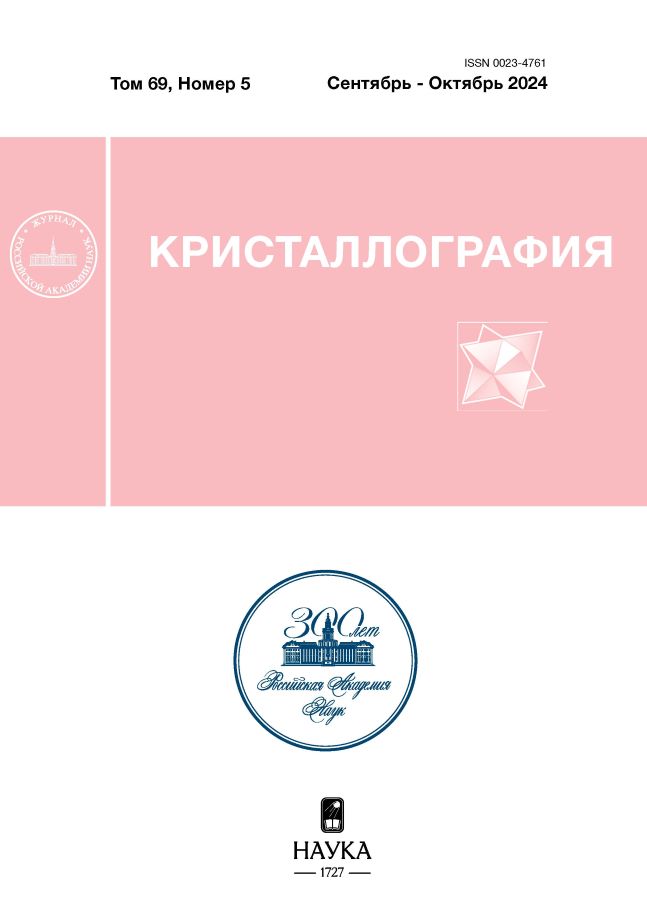Applicability of the MARTINI coarse-grained force field for simulations of protein oligomers in crystallization solution
- Authors: Kordonskaya Y.V.1, Timofeev V.I.1,2, Marchenkova M.A.1,2, Pisarevsky Y.V.2, Dyakova Y.A.1, Kovalchuk M.V.1,2
-
Affiliations:
- National Research Centre "Kurchatov Institute"
- Shubnikov Institute of Crystallography of Kurchatov Complex of Crystallography and Photonics of NRC “Kurchatov Institute”
- Issue: Vol 69, No 5 (2024)
- Pages: 885-890
- Section: CRYSTAL GROWTH
- URL: https://rjdentistry.com/0023-4761/article/view/673751
- DOI: https://doi.org/10.31857/S0023476124050159
- EDN: https://elibrary.ru/ZBQTXI
- ID: 673751
Cite item
Abstract
The molecular dynamics of two types of lysozyme octamers was simulated under crystallization conditions in the MARTINI coarse-grained force field. Comparative analysis of the obtained results with the simulation data for the same octamers modelled in the all-atom field Amber99sb-ildn showed that octamer “A” demonstrates greater stability compared to octamer “B” in both force fields. Thus, the results of molecular dynamics simulations of octamers using both force fields are consistent. Despite several differences in the behavior of the protein in different fields, they do not affect the validity of the data obtained using MARTINI. This confirms the applicability of the MARTINI force field for studying crystallization solutions of proteins.
Full Text
About the authors
Y. V. Kordonskaya
National Research Centre "Kurchatov Institute"
Author for correspondence.
Email: yukord@mail.ru
Russian Federation, 123182 Moscow
V. I. Timofeev
National Research Centre "Kurchatov Institute"; Shubnikov Institute of Crystallography of Kurchatov Complex of Crystallography and Photonics of NRC “Kurchatov Institute”
Email: yukord@mail.ru
Russian Federation, 123182 Moscow; Moscow
M. A. Marchenkova
National Research Centre "Kurchatov Institute"; Shubnikov Institute of Crystallography of Kurchatov Complex of Crystallography and Photonics of NRC “Kurchatov Institute”
Email: yukord@mail.ru
Russian Federation, 123182 Moscow; Moscow
Y. V. Pisarevsky
Shubnikov Institute of Crystallography of Kurchatov Complex of Crystallography and Photonics of NRC “Kurchatov Institute”
Email: yukord@mail.ru
Russian Federation, Moscow
Y. A. Dyakova
National Research Centre "Kurchatov Institute"
Email: yukord@mail.ru
Russian Federation, 123182 Moscow
M. V. Kovalchuk
National Research Centre "Kurchatov Institute"; Shubnikov Institute of Crystallography of Kurchatov Complex of Crystallography and Photonics of NRC “Kurchatov Institute”
Email: yukord@mail.ru
Russian Federation, 123182 Moscow; Moscow
References
- Kovalchuk M.V., Blagov A.E., Dyakova Y.A. et al. // Cryst. Growth Des. 2016. V. 16. № 4. P. 1792. https://doi.org/10.1021/acs.cgd.5b01662
- Marchenkova M.A., Volkov V.V., Blagov A.E. et al. // Crystallography Reports. 2016. V. 61. № 1. P. 5. https://doi.org/10.1134/S1063774516010144
- Boikova A.S., D’yakova Y.A., Il’ina K.B. et al. // Crystallography Reports. 2018. V. 63. № 6. P. 865. https://doi.org/10.1134/S1063774518060068
- Kovalchuk M.V., Boikova A.S., Dyakova Y.A. et al. // J. Biomol. Struct. Dyn. 2019. V. 37. № 12. P. 3058. https://doi.org/10.1080/07391102.2018.1507839.
- Marchenkova M.A., Konarev P.V., Rakitina T.V. et al. // J. Biomol Struct. Dyn. V. 38. № 10. P. 2939. https://doi.org/10.1080/07391102.2019.1649195
- Marchenkova M.A., Boikova A.S., Ilina K.B. et al. // Acta Naturae. 2023. V. 15. № 1. P. 58. https://doi.org/10.32607/ACTANATURAE.11815
- Kordonskaya Y.V., Timofeev V.I., Dyakova Y.A. et al. // Crystallography Reports. 2018. V. 63. № 6. P. 947. https://doi.org/10.1134/S1063774518060196
- Kordonskaya Y.V., Timofeev V.I., Marchenkova M.A., Konarev P.V. // Crystals. 2022. V. 12. № 4. P. 484. https://www.mdpi.com/2073-4352/12/4/484
- Kordonskaya Y.V., Timofeev V.I., Dyakova Y.A. et al. // Mend. Commun. 2023. V. 33. № 2. P. 225. https://doi.org/10.1016/J.MENCOM.2023.02.024
- Cerutti D.S., Le Trong I., Stenkamp R.E., Lybrand T.P. // Biochemistry. 2008. V. 47. № 46. P. 12065. https://doi.org/10.1021/bi800894u
- Cerutti D.S., Le Trong I., Stenkamp R.E., Lybrand T.P. // J. Phys. Chem. B. 2009. V. 113. № 19. P. 6971. https://pubs.acs.org/doi/full/10.1021/jp9010372
- Cerutti D.S., Freddolino P.L., Duke R.E., Case D.A. // J. Phys. Chem. B. 2010. V. 114. № 40. P. 12811. https://doi.org/10.1021/jp105813j
- Taudt A., Arnold A., Pleiss J. // Phys. Rev. E. 2015. V. 91. № 3. P. 033311. https://journals.aps.org/pre/abstract/10.1103/PhysRevE.91.033311
- Meinhold L., Merzel F., Smith J.C. // Phys. Rev. Lett. 2007. V. 99. № 13. P. 138101. https://doi.org/10.1103/PhysRevLett.99.138101
- Marrink S.J., Periole X., Tieleman D.P., De Vries A.H. // Phys. Chem. Chem. Phys. 2010. V. 12. № 9. P. 225. https://doi.org/10.1039/B915293H
- Marrink S.J., Risselada H.J., Yefimov S. et al. // J. Phys. Chem. B. 2007. V. 111. № 27. P. 7812. https://pubs.acs.org/doi/full/10.1021/jp071097f
- Monticelli L., Kandasamy S.K., Periole X. et al // J. Chem. Theory Comput. 2008. V. 4. № 5. P. 819. https://pubs.acs.org/doi/abs/10.1021/ct700324x
- Marrink S.J., Monticelli L., Melo M.N. et al. // Wiley Interdiscip Rev. Comput. Mol. Sci. 2022. V. 13. № 1. P. e1620. https://onlinelibrary.wiley.com/doi/full/10.1002/wcms.1620
- Kroon P.C., Grünewald F., Barnoud J. et al. // 2022. https://arxiv.org/abs/2212.01191v3
- Souza P.C.T., Alessandri R., Barnoud J. et al. // Nature Methods. 2021. V. 18. № 4. P. 382. https://www.nature.com/articles/s41592-021-01098-3
- Van Der Spoel D., Lindahl E., Hess B. et al. // J. Comput. Chem. 2005. V. 26. № 16. P. 1701. https://doi.org/10.1002/jcc.20291
- Wassenaar T.A., Ingólfsson H.I., Böckmann R.A. et al. // J. Chem. Theory Comput. 2015. V. 11. № 5. P. 2144. https://pubs.acs.org/doi/abs/10.1021/acs.jctc.5b00209
- Bernetti M., Bussi G. // J. Chem. Phys. 2020. V. 153. № 11. Р. 114107. https://doi.org/10.1063/5.0020514
- Berendsen H.J.C., Postma J.P.M., Van Gunsteren W.F. et al. // J. Chem. Phys. 1984. V. 81. № 8. P. 3684. https://doi.org/10.1063/1.448118
- Parrinello M., Rahman A. // J. Chem. Phys. 1982. V. 76. № 5. P. 2662. https://doi.org/10.1063/1.443248
- Van Gunsteren W.F., Berendsen H.J.C. // Mol. Simul. 1988. V. 1. № 3. P. 173. https://doi.org/10.1080/08927028808080941
- Hünenberger P.H., Van Gunsteren W.F. // J. Chem. Phys. 1998. V. 108. № 15. P. 6117. https://doi.org/10.1063/1.476022
- Hess B., Bekker H., Berendsen H.J.C., Fraaije J.G.E.M. // J. Comput. Chem. 1997. V. 18. P. 1463. https://doi.org/10.1002/(SICI)1096-987X(199709)18:12<1463::AID-JCC4>3.0.CO;2-H
Supplementary files













